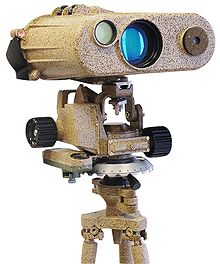Rangefinder




Arangefinder(alsorangefinding telemeter,depending on the context) is a device used tomeasure distancesto remote objects. Originally optical devices used insurveying,they soon found applications in other fields, such as photography, the military, and space travel. They were especially useful for finding the range of a target, such as innaval gunneryandanti-aircraft artillery.The wordtelemeteris derived fromAncient Greekτῆλε(têle)'distant, far away', andμέτρον(métron)'something used to measure'.
Designs[edit]

The first rangefinder telemeter was invented byJames Wattin 1769 and put to use in 1771 in surveying canals. Watt called his instrument a micrometer, a term now used with a different meaning in engineering (themicrometer screw gauge). It consisted of two parallelhairsin the focal plane of a telescopeeyepiececrossing an upright hair. At the point to be measured, two sliding targets on a surveyor's rod were adjusted to align with the hairs in the telescope. The distance to the rod could then be determined from the distance between the targets on the rod by trigonometry.[1]
Several others have been credited with the invention of the rangefinder telemeter at one time or another. TheRoyal Society of Artsgave an award to W. Green for its invention in 1778, even though they were made aware of Watt's priority.[2]
In 1778,Georg Friedrich Branderinvented thecoincidence rangefinder.Two mirrors set a distance apart horizontally in a long slim box, similar to asubtense barbut located at the measuring station, and forming two images. This rangefinder does not require a measuring rod at the target and could perhaps be considered the first true telemeter. In 1790Jesse Ramsdeninvented a half-image range finder. ThoughAlexander Selligueis often mistakenly credited with the invention, he did invent an improved rangefinder with fixed lenses in 1821 and is responsible for coining the term.[3][4]
In 1881, the BritishRoyal Artilleryadopted thedepression range finder,which had been developed by Captain H.S.S. Watkin for use bycoastal artillery.It used the measurement of the angle of depression from the observer, sited on a high vantage point, to the waterline of the target vessel.[5]
In 1899,Carl PulfrichatCarl Zeiss AGfabricated a practicalstereoscopic rangefinder,[6]based on a patent of Hector Alexander de Grousilliers.[7]
World War II-era rangefinders worked optically with two telescopes focused on the same target but a distance apart along a baseline. The range to the target is found by measuring the difference in bearing of the two telescopes and solving theskinny triangle.Solutions can be obtained automatically, using tables or, rarely, manual calculation. The greater the distance to the target, the longer the baseline needs to be for accurate measurement. Modern rangefinders use an electronic technology such aslasersorradar.
Laser rangefinder[edit]

Applications[edit]
Applications includesurveying,navigation,to assist focusing inphotography,choosing agolf clubaccording to distance, and correcting aim of a projectileweaponfor distance.
Golf[edit]
Laser rangefinders are used in golf to measure the yardage of a particular shot but also to gauge slope and wind as well. There has been debate over whether they should be allowed in tournaments. While their use is banned on the professional level, they are becoming widely used on the amateur level.[8][9]
Ballistics[edit]
Rangefinders may be used by users offirearmsover long distances, to measure the distance to a target to allow for projectile drop.[10]Until the development of electronic means of measuring range during theSecond World War,warships used very large optical rangefinders—with a baseline of many meters—to measure range for naval gunnery.
Forestry[edit]
Rangefinders are used for surveying in forestry. Special devices with anti-leaf filters are used.
Virtual reality[edit]
Since the 1990s, rangefinders have been used invirtual realitysystems to detect operator movements and locate objects.[11]
See also[edit]
References[edit]
- ^Dickinson, 2010 pp. 56, 75-76
- ^Dickinson, 2010. pp. 76-77
- ^Johann Gottfried Dingler,Polytechnisches Journal,vol. 8, page 121, Stuttgart: Cotta 1822OCLC183328327(in German)
- ^A. Rittig von Flammenstern,Archiv für Geographie, Historie, Staats- und Kriegskunst,vol. 13, Franz Härter: Wien, page 561 (in German)
- ^Sambrook, Stephen C (2015).The Optical Munitions Industry in Great Britain, 1888–1923.Taylor & Francis. p. 27.ISBN978-1-317-32103-3.
- ^Fritz Deumlich,Surveying Instruments,Walter de Gruyter, 1982ISBN3110077655(p.15)
- ^GB patent 189317048,Hector Alexander de Grousilliers, "Improved Stereoscopic Telemeter.", issued 1894-07-14
- ^"Golf Rangefinder Comparison Chart at Golfsmith." Golf Rangefinder Comparison Chart at Golfsmith. N.p., n.d. Web. 06 Nov. 2014.
- ^"While We're Young, USGA." Golf. N.p., n.d. Web. 06 Nov. 2014.
- ^Farey, Pat and Spicer, Mark (2009)Sniping: An Illustrated HistoryZenith Press, Grand Rapids, Michigan,page 7,ISBN978-0-7603-3717-2
- ^Kidd, Cory D.et al.(1999) "The aware home: A living laboratory for ubiquitous computing research"Lecture Notes in Computer Science1670: pp. 191–198,doi:10.1007/10705432_17
- Dickinson, H. W. (2010),James Watt: Craftsman and Engineer,Cambridge University Press,ISBN978-1108012232
Further reading[edit]
- "Range Finder (instrument)." Encyclopædia Britannica Online. Encyclopædia Britannica,
- Army Test and Evaluation Command, Aberdeen Proving Ground Maryland (1969)Laser RangefindersFt. BelvoirDefense Technical Information Center,U.S. Army, Ft. Belvoir, Virginia,OCLC227620848(early history of the use of lasers in rangefinders)
- Photographic and Imaging Manufacturers Association (1999)American national standard for photography (optics): rangefinders and other focusing aids – performance specifications(revision and redesignation of "ANSI PH3.619-1988" as "ANSI/PIMA IT3.619-1998" ) American National Standards Institute, New York,OCLC41501265
- Hicks, Roger and Schultz, Frances (2003)Rangefinder: Equipment, History, TechniquesGuild of Master Craftsman, Lewes, UK,ISBN1-86108-330-0
- Notes on rangefinders, compasses and on contouring with the Scale of Horizontal Equivalents(PDF),Infantry and Cavalry School Lectures 1902-1910, Staff College Press, U.S. Army, Fort Leavenworth, Kansas, 1905,OCLC278057724,archived fromthe original(PDF)on 2016-03-03 – via archive.org
- Whitehouse, J. C. (2005) "Further considerations of defocus rangefinders"Transactions of the Institute of Measurement and Control27(4): pp. 297–316
- Range-Finding in the Army. How to use range-finders to get results: the erect and inverted types,Popular Sciencemonthly, February 1919, page 118–120, Scanned by Google Books
- Electro Optic Application Test Equipment,Berkeley Nucleonics Corporation, archived fromthe originalon 2011-07-11
